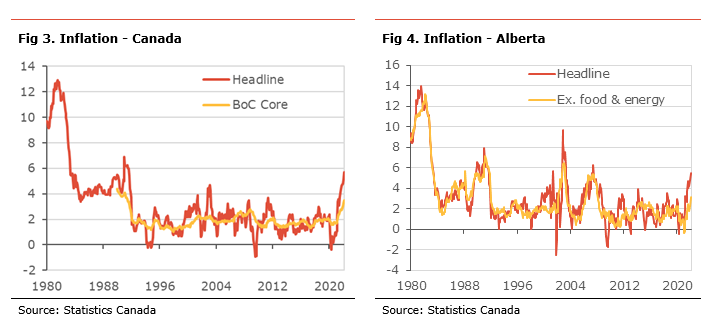Economic insight provided by Alberta Central Chief Economist Charles St-Arnaud.
Bottom line
Inflation continued to accelerate in March with its biggest monthly increase since the introduction of the GST in 1991 and reaching a level not seen since 1983. The high level of inflation continues to be mainly due to a handful of components: gasoline prices, food prices, homeowners’ costs, utilities costs and motor vehicles prices. Altogether, these five items are responsible for about 4.3 percentage points of the 5.7% inflation rate. Nevertheless, inflationary pressures are broad, with two-thirds of the components of CPI rising at more than 3% y-o-y (see Fig 1) and various core measures of CPI accelerating sharply.
Additionally, the recent trend in the CPI monthly changes suggests that inflationary pressures remain elevated. As such, the 3-month annualized change in most of the CPI components remains well above 3% and above their year-on-year changes (see Fig. 2). These pressures are partly due to supply constraints resulting from the pandemic, a surge in shipping costs and the broad-based increase in commodity prices, especially energy.
The sharp increase in commodity prices since the invasion of Ukraine by Russia will lead to further inflationary pressures and will push inflation higher in the coming months (see).
With inflation well above its target of 2% and more persistent than initially thought, inflation expectations rising and a broadening of inflationary pressures, we believe the Bank of Canada will continue to hike interest rates. Our view remains that the BoC will increase its policy rate by 50bp at the June meetings. However, with core inflation coming in well above expectations, we believe the BoC will continue to aggressively increase its policy rate in the second half of the year. We wouldn’t be surprised to see another 50bp hike at the July meeting if inflation remains elevated in the coming months.
In Alberta, inflation remained jumped to 6.5%. As is the case nationally, most of the inflation is due to higher energy costs (gasoline, electricity and natural gas), motor vehicles and food prices. We note that core inflation for the province also jumped higher in March but remains slightly lower than in the rest of the country at 4.3%.
The Consumer Price Index (CPI) increased by 1.4% m-o-m non-seasonally-adjusted in March, the biggest monthly price increase since the introduction of the GST in 1991. The inflation rate accelerated to 6.7%, its highest level since 1983. Prices rose on the month in all of the eight major CPI components, with transportation (+3.5% m-o-m), recreation, education and reading (+1.8% m-o-m), and household operations, furnishing and equipment (+1.2% m-o-m) increasing the most. On the flip side, health and personal care (+0.2% m-o-m), alcohol, tobacco and cannabis(+0.4% m-o-m), and clothing and footwear (+0.7% m-o-m) saw the smallest increase on the month.
The increase in transportation (+0.6 percentage points (pp)), shelter (+0.3pp), household operations, furnishing and equipment (+0.2pp), and recreation, education and reading (+0.2pp) were the main contributors to the monthly increase in CPI. Gasoline prices increased 11.8% m-o-m and were responsible for most of the rise in transportation costs contributing 0.4pp to the monthly increase in CPI.
Six of the eight major CPI components accelerated in March on a year-on-year basis, led by transportation costs, food prices, and shelter costs. Transportation costs acccelerated to 11.2% y-o-y, contributing 1.8pp to inflation, with gasoline prices being the main source of cost increases in the category (+39.8% y-o-y contributing 1.4pp). Food prices inflation reached its highest since 2009 at 7.7% and contributed 1.3pp to inflation. Shelter costs rose 6.8% y-o-y, the highest since 1983, as owned accommodation costs, mainly homeowners’ replacement costs and other owned accommodation costs continue to increase. Shelter costs are the primary source of inflation, contributing 2.0 percentage points (pp) to inflation.
In March, goods prices inflation accelerated to 9.2% from 7.6% and services inflation to 4.3% from 3.8%. Energy prices also accelerated, increasing by 27.8% since March last year. Excluding food and energy, prices rose 0.9% on the month and increased by 4.6% compared to the same month the previous year, the fastest since 1991. The Bank of Canada’s old measure of core inflation, CPI excluding the 8 most volatile components and indirect taxes, edged higher to its highest level since records started in 1984 at 5.5%.
Looking at the BoC’s core measures of inflation, they all accelerated in March. CPI-Trim rose to 4.7 % form 4.4%, CPI-Median to 3.8% from 3.5% and CPI-Common to 2.8% from 2.7%. The average of the core measures increased to 3.8%, its highest since 1991.
In Alberta, inflation accelerated to 6.5% in March, the highest since 2003. Transportation costs remain the main contributor to inflation (contributing +2.8pp) due to increased gasoline prices and motor vehicle prices. Shelter costs are another important contributor to inflation (contributing +1.5pp), mainly due to rising utilities costs, especially electricity and natural gas prices, owned accommodation costs. Food prices are also an important source of inflation, contributing +1.1pp. Goods price inflation increased to 9.7% and services price inflation rose to 3.3%. Inflation excluding food and energy jumped to 4.3, while energy costs decelerated slightly to 30.7% compared to the same month last year.





Independent Opinion
The views and opinions expressed in this publication are solely and independently those of the author and do not necessarily reflect the views and opinions of any organization or person in any way affiliated with the author including, without limitation, any current or past employers of the author. While reasonable effort was taken to ensure the information and analysis in this publication is accurate, it has been prepared solely for general informational purposes. There are no warranties or representations being provided with respect to the accuracy and completeness of the content in this publication. Nothing in this publication should be construed as providing professional advice on the matters discussed. The author does not assume any liability arising from any form of reliance on this publication.
Alberta Central member credit unions can download a copy of this report in the Members Area here.